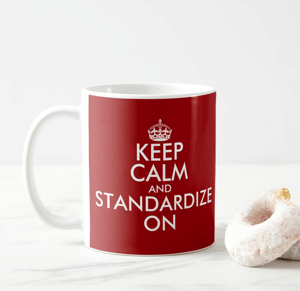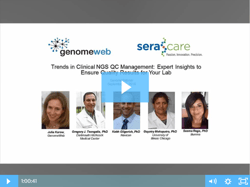There is that old adage that says the only thing that is constant is change. This is one of those universal truths we have all come to accept. Heck, even Dunkin' Donuts, widely credited as being the inventor of the word “Donut,” is dropping the word from their brand name. Blasphemy! But that is for another blog...
 Clinical genomics has experienced dramatic changes in the last two decades, particularly with next-generation sequencing (NGS). While NGS offers great power and promise as a clinical diagnostic modality, a complex, multi-step process is needed to deliver results. Each of the workflow components (e.g., DNA/RNA extraction methods, library prep, PCR reagents, sequencing reagents, informatics algorithms) are also constantly evolving, suggesting that robust QC management strategies are needed to help cope with the rapid change we are experiencing.
Clinical genomics has experienced dramatic changes in the last two decades, particularly with next-generation sequencing (NGS). While NGS offers great power and promise as a clinical diagnostic modality, a complex, multi-step process is needed to deliver results. Each of the workflow components (e.g., DNA/RNA extraction methods, library prep, PCR reagents, sequencing reagents, informatics algorithms) are also constantly evolving, suggesting that robust QC management strategies are needed to help cope with the rapid change we are experiencing.
Recently, a webinar, Trends in Clinical NGS QC Management, was conducted where a panel of experts discussed the results of a first-of-its-kind NGS QC survey that was conducted by GenomeWeb and SeraCare. The webinar was moderated by Dr. Gregory Tsongalis, Director of the Laboratory for Clinical Genomics and Advanced Technology at Dartmouth-Hitchcock Medical Center, and included a panel of experts including Dr. Keith Gligorich (NAVICAN), Dr. Gayatry Mohapatra, PhD (University of Illinois), and Dr. Seema Rego (Illumina). The panel discussed key questions gleaned from the results of the survey.
Dr. Tsongalis led off the webinar with some very eye-opening trends that were highlighted by the survey. One of the more noteworthy findings from the survey was that almost 30% of labs use positive run controls only on new lots, or not even at all. Additionally, about 52% of labs experience QC stops at least monthly.
A reasonable question from those attending the webinar would be to ask, 'why do so many labs experience QC stops?' There are many possible reasons including inadequate assay validation, reagent variability, operator training, instrument drift, or software limitations. A logical follow-up question then is if labs used run controls, wouldn’t they be able to troubleshoot the cause of run failure more quickly, ultimately saving time and money?
The urgency of this question becomes even more pronounced when considering that the survey revealed that 74% of labs take a day or more to resolve NGS QC stops and that 55% of labs want to troubleshoot runs more quickly.
Dr. Tsongalis observed during this portion of the webinar that the state of QC management in clinical NGS reminded him of when PCR was emerging as a clinical diagnostic modality. I found this very interesting and it caused me to reflect back almost 20 years in my own career in the life sciences. I recall a repeatable pattern where scientific innovation occurs, then stabilizes in order to be applied to its full clinical potential. Examples of this were capillary electrophoresis sequencing, flow cytometry, mass spectroscopy, DNA microarray, and yes, PCR. Are we there now with clinical NGS?
The first topic the panel tackled was when exactly, should a lab begin to think about a quality management program? Dr. Rego noted that during the validation planning phase would be optimal; the rest of the panel concurred. The main reasons for this are to use the validation data to set pass/fail thresholds and to track QC data longitudinally even before the lab begins routine testing.
Another key topic that was discussed is what kind of NGS reference standards were optimal, and how often should they be used? The panel unanimously agreed that commercial NGS reference materials offer great benefit when used routinely, within each run. Remnant clinical patient samples were discussed and several concerns were raised with using remnant samples as positive controls. The panel noted that remnant samples are impacted by variability related to ischemia, sample processing, and even tumor content which can lead to inconsistent results. Additionally, patient remnant samples will not contain all the relevant variants that a clinical NGS assay is intended to interrogate. Dr. Mohapatra observed that institutional guidelines may also govern how much of a patient block can be used, as patients in many cases may ask for access to their own samples at a later date. During this discussion it became very clear that if a laboratory is seeking to implement best practices with respect to a QC management strategy, commercially available reference materials are the preferred choice.
Underscoring the panelists views, Dr. Tsongalis described a run in his own lab with atypical results. When they investigated further, the block they had used to derive their reference material had all of its tumor content depleted. Dr. Tsongalis also noted commercially available reference materials themselves undergo rigorous good manufacturing practices which would be difficult for a lab to emulate.
On the topic of how often a lab should utilize reference materials, Dr. Gligorich noted that his laboratory believes that having the ability to monitor sensitivity, longitudinally, on every run is very powerful especially for low level variants of clinical significance which further ensures their laboratory is providing the right results.
Dr. Tsongalis summed up the current state of clinical NGS testing very succinctly: "The largest problem in the state of clinical NGS testing today is the lack of standardization and this survey shows that there is room for improvement across the board. I’ve never seen anything in my career where there so many options on how to do testing. All of the choices in instruments and assays may explain the lack of standardization but it is important for labs to increase their use of appropriate materials, tools, and fully align with the guidelines published by organizations such as CAP and AMP.”
The incredible amount of innovation we have seen in clinical genomics is benefiting us all and we will continue to see more innovation as time goes by. As Dr. Tsongalis pointed out with his reference to PCR, there is an inflection point where innovation becomes “ready for prime time” in the clinical setting. I would like to suggest that we are at that inflection point today with clinical NGS. Multiple consortia are being formed to work collectively towards clinical NGS assay consistency. Manufacturers of commercially available solutions for NGS-based diagnostics are beginning to receive FDA clearances, suggesting that these manufacturers are achieving a level of consistency and stability needed for clinical use. The increased use of robust run controls with fit-for-purpose QC management solutions are also enabling assay standardization to help ensure consistency of results.
Change is constant, and this is a good thing! The opportunity is now here for us to leverage innovation with operational excellence for the benefit of us all.
Keep Calm and Standardize On.
 Recorded Webinar and Survey Report
Recorded Webinar and Survey Report
Trends in Clinical NGS QC Management: Expert Insights to Ensure Quality Results for Your Lab
Learn how QC has been implemented by your peers as the panel expands on the results of the most comprehensive survey to date on NGS QC practices.





